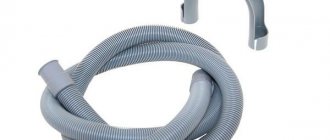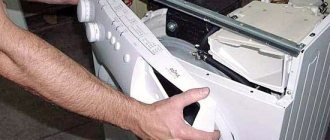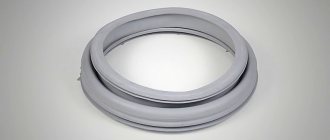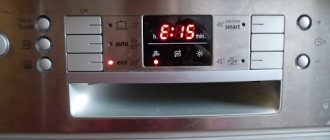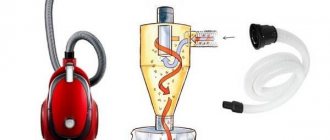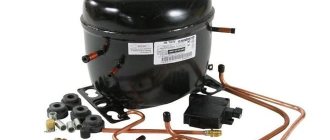Poor-quality tap water is dangerous not only for humans, but also for any household appliances with which it comes into direct contact. A dishwasher, be it Bosch, Siemens or Ariston, is no exception. To protect expensive equipment from premature breakdowns and maintain proper quality of dishwashing, you need to take care to improve the quality of the water itself. Installing a special filter device will help solve the problem. What is a water supply filter for a dishwasher and how to choose the right one, we will tell you in this article.
Do you need a water filter?
Most dishwashers are designed with a partial cleaning system. It includes:
- Deep (coarse) filter, which is installed on the inlet valve. It purifies water from fine dirt, sand, and rust before it enters the machine.
- Built-in ion exchanger. It reduces its hardness, thereby protecting the heating elements of the machine from scale formation, and also improves the quality of washing dishes.
Often these standard means are not enough. A flow-through cleaner cannot handle excessive amounts of heavy metals. The ion exchanger needs constant updating (regular replenishment of special softening salt, which is used in dishwashers). The volume of ionic material is small, so with increased hardness it is consumed much faster.
A complete solution to this problem is to install filters that can both soften water (if it is too hard) and purify it from various impurities.
How to determine which filter is needed? First of all, you need to know the quality of tap water in order to understand what impurities it contains. You can do this in the following ways:
- Conduct laboratory analysis. This method is the most reliable, but expensive. Based on the results obtained in the laboratory, the necessary remedy is selected.
- Use special test strips. With their help you can determine hardness, pH level, etc. The readings from such special devices are less reliable. But there is enough data to determine what kind of cleaner is needed.
- Conduct your own observation. Observe how quickly scale forms in the kettle. Take a closer look at the clarity of the water that comes out of the tap. Perhaps you “catch” a foreign odor in it. Sometimes such information is quite enough to select one or another cleaner.
Having figured out all the “water problems”, you can safely go shopping for additional protection for your equipment.
Cleaning spray nozzles
No matter how well the filter reduces the degree of water contamination, small particles can still pass through the fine mesh. If you add limescale to them, the total contaminants can clog the holes in the spray arms. Therefore, their visual inspection and periodic cleaning are also necessary.
Sprinkler nozzles that need to be checked and cleaned from time to time
The quality of washing kitchen utensils depends on the cleanliness of the holes in the rocker arms. Therefore, periodically perform the following procedure:
- Remove the upper basket from the chamber to which the spray arm is attached.
- Remove the spray arm by pulling out the latches.
- Lift out the lower basket and remove the lower spray arm.
- Remove grease deposits by washing the blades with detergent and water. Check the condition of the holes by running a stream of water into the nozzles. Clean clogged holes with a toothpick or any similar object.
- Install in reverse order.
Removing the upper arm of the sprinkler
If you have difficulty removing the sprinklers, use the instructions for your PMM.
Softening filters
The choice of softeners is quite large. Polyphosphate or salt devices are popular among users, as they are easy to install and operate.
The design is a plastic flask with a filler (food grade sodium polyphosphate) inside. Softening occurs due to a chemical reaction: polyphosphate salts dissolve in the liquid passing through it and form a protective film. It is this that binds hardness salts and prevents them from settling on vulnerable parts of dishwashers.
Such softeners are installed in the inlet hose, directly in front of the PMM. And their operation consists of timely filling of a new reagent.
It is impossible to install polyphosphate softeners on a public water supply, since the liquid after salt cleaning will become undrinkable.
The following water purifiers for dishwashers have proven themselves:
- Aquaphor Stiron. Inexpensive and economical softener. One fill is enough for approximately 400 washing cycles.
- Prio® New Water B120. The resource of one backfill is enough for six months before replacement (depending on the frequency of use of the equipment).
As an alternative to polyphosphate cleaners, you can use a reagent-free softener with a magnetic operating principle.
Under the influence of a magnetic field, ions of hardness salts lose their properties, therefore, there is simply nothing for the limescale deposit to form from. Such devices have a long service life and high efficiency, but are also very expensive.
You can see how the magnetic cleaner works in the video:
What should be the length of the dishwasher hose: choosing a new hose
Before talking about the optimal length of a dishwasher hose, it should be said that any equipment is equipped with two hoses: drain and fill. Both hoses are connected to the water supply. The drain, in this case, can be led either to the sink drain or connected directly to the sewer. Both hoses are made of high-quality materials, and therefore malfunctions rarely occur. However, sometimes there are situations when the sleeve needs to be replaced. When choosing a new hose, you need to make sure that its length meets the standards.
Thus, the optimal length for drain and inlet hoses is considered to be 2.5 meters.
You can buy a hose for a dishwasher at a hardware store or specialty store.
At the same time, the hoses themselves are available in sizes from 1.5 to 5 meters. Sleeves are sold by the metre: they can cut off as many meters as you need.
In addition, when choosing a dishwasher hose, you need to pay attention to:
- Sleeve material. So, the inlet hose must be made of polyvinyl chloride.
- The inlet hose has a technical passport. This document must indicate such operating characteristics of the element as the maximum possible water pressure and operating temperature range. Thus, hoses for cold water supply are usually designed for temperatures of 20-250C, for hot water – 60-700C.
- The presence of fittings with union plastic nuts at the ends of the hoses. In this case, one hose must have both an angled and a straight fitting (the first is attached to the machine). Some hoses have a special Aquastop filter in their design, the main purpose of which is to protect against water leakage.
If the hose does not need to be replaced, but simply extended, then for this you will have to purchase a special coupling.
Coarse filters
Such devices are intended exclusively for mechanical purification of water from impurities (sand, rust), but not for softening it. They are installed in the same place as salt ones - in front of the dishwasher.
They are also unpretentious in installation and operation. But they have a significant drawback: they have to be cleaned very often, as they quickly become clogged with debris.
The filter device for coarse cleaning built into the dishwasher performs a slightly different, but no less important function. It prevents clogs in the drain hose and circulation pump by trapping leftover food, napkins and other small debris after washing dishes.
The operation of many important components of the PMM depends on its proper functioning. In all dishwashers, be it Hansa, Beko or Whirlpool brand appliances, it looks almost the same. But if you need to replace it, then you should select an original spare part from a specific manufacturer.
Are filters for different purposes installed at the same time? Definitely yes. Moreover, an integrated approach to solving this problem is recommended by both specialists and the manufacturers of household appliances themselves. Whether or not to install additional softeners and cleaners for the dishwasher is up to you. But if you count on long-term and high-quality operation of your equipment, you should not refuse this.
Useful video:
Instructions: how to install a dishwasher (video)
An automatic dishwasher is a complex installation that has made life easier for every housewife. The long service life of the device and the safety of its use depend on whether the machine has been connected correctly and whether a filter is used to purify the water. The tips from experienced professionals listed above will help you install the equipment correctly, protecting your property and the equipment itself from damage. Connect the dishwasher and enjoy excellent results without wasting your own time and energy!
Tips for caring for your dishwasher
- follow the rules for operating the device: load dishes correctly (place plates, pots in the lower compartment, cups in the upper compartment), and the devices should not come into contact with each other;
- After each use of the device, wipe its surfaces, seals, and door with a damp cloth;
- remove all dirt immediately, without waiting for a “general” wash;
- Periodically deep clean the device, wash filters, baskets, blades, seals, and housing.
At the end of the wash cycle, always leave the machine door open unless your appliance is designed to dry automatically (many modern Bosch models have been improved with built-in fans, so the inside of the appliance always remains dry.
Regularly performing simple cleaning procedures for your household appliance will improve its performance and extend the life of the machine.
Using salt
During the use of the dishwasher, scale and limescale deposits may evenly form on the walls of its inner chamber. These deposits appear due to the hardness of the water, a prerequisite for which is calcium and magnesium in it. The more of these parts your tap water contains, the higher the hardness level. A special highly purified salt that softens the water helps protect the dishwasher. It should be added to the detergent during each wash cycle. You can also use pills that already contain salt. But for water with the highest level of hardness, this is not enough, and you will still have to add salt. If scale or deposits have already appeared, wash the machine using a descaling agent.
From time to time, yellowish or brown spots appear on the walls of the inner chamber of the dishwasher, which indicates an excessive iron content in the water. To prevent the appearance of such stains, you need to purchase and install a special filter . It is attached to the hose used to supply water.
Cleaning and disinfecting the chamber
To clean the inside of the dishwasher, treat the entire interior surface of the dishwasher with a sponge soaked in a solution of dishwashing detergent that dissolves grease deposits well. Pay special attention to hard-to-reach corners where the most dirt accumulates. You can use dishwasher care products.
Cleaning the dishwasher chamber
In order for an unpleasant odor to appear in the machine, the door must be opened regularly for ventilation. In particularly advanced cases, bleach will help get rid of mold. But it must be used with extreme caution, since this composition is chemically active. It can even damage the metal inside the PMM, not to mention the sealing gaskets and plastic structural elements.

